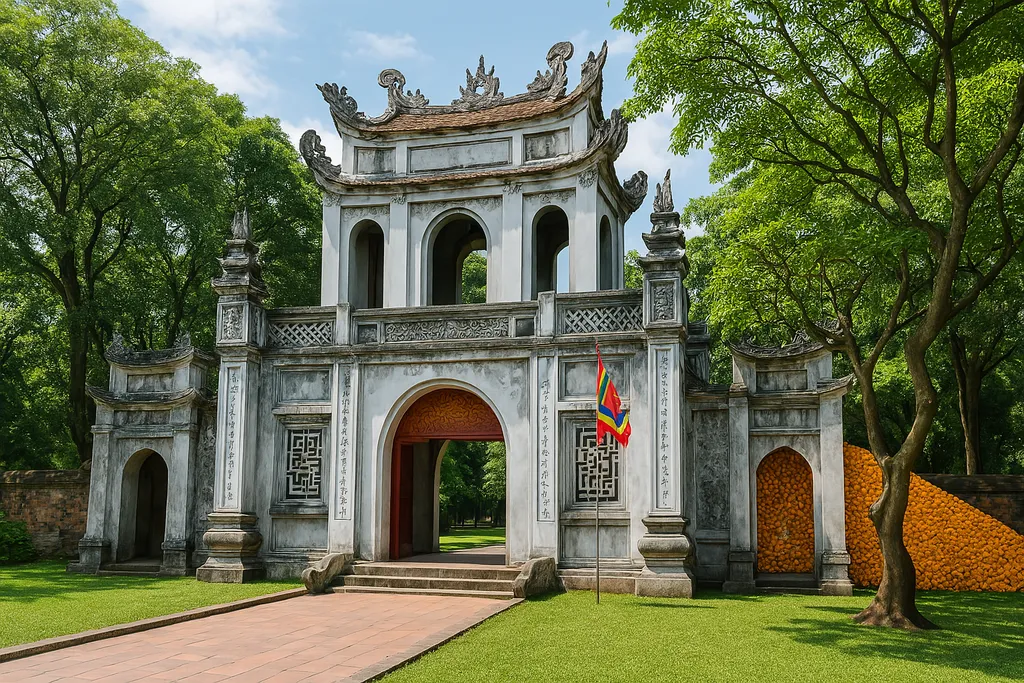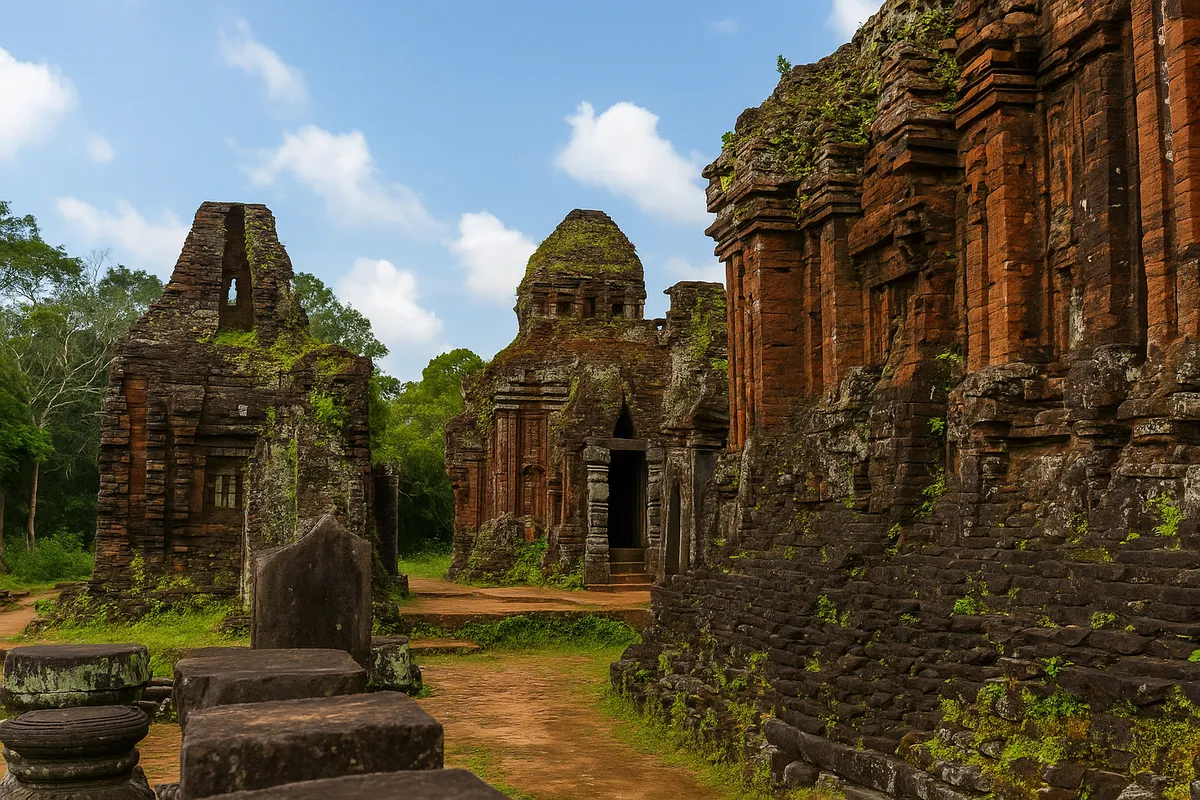The Temple of Literature: Hanoi’s Timeless Sanctuary of Knowledge
- Thursday, Apr 10, 2025, 05:20 (GMT+7)
The Temple of Literature: Hanoi’s Timeless Sanctuary of Knowledge
In the heart of Hanoi—where scooters buzz like a swarm of bees, where modern cafés flirt with the rhythm of daily life, and where the air hums with an energy that never sleeps—there exists a place where time slows down, where silence speaks, and where the soul feels gently tugged into reflection. It is here, behind ancient stone walls and moss-covered gates, that you will find the Temple of Literature, or Văn Miếu – Quoc Tu Giam, Vietnam’s first university and one of the nation’s most treasured cultural legacies.
Imagine stepping through a centuries-old gate—its arch curved like a smile, its wooden beams weathered but dignified. This is the Tam Quan gate, and once you pass under its roof, the chaos of the city fades. The air is cooler. The wind smells faintly of incense and old trees. It is like entering another dimension, a still and sacred space that has existed for over a thousand years.
Founded in 1070 by Emperor Ly Thanh Tong, the Temple of Literature was originally built to honor Confucius and the great sages of Eastern philosophy. But it quickly grew into something more than a shrine—it became a cradle of knowledge, nurturing generations of Vietnamese scholars. Just six years after its construction, Vietnam’s first national university, Quoc Tu Giam, was established within its grounds. For nearly eight centuries, this was where the country’s brightest minds came to study, to debate, and to dream of a better world.
Strolling along the temple’s tree-lined path, you come upon its most iconic architectural jewel: Khue Van Cac. Built in 1805, this delicate, wooden pavilion rests atop four stone pillars and is adorned with round windows shaped like radiant suns. Its name roughly translates to “The Pavilion of the Constellation of Literature,” a poetic tribute to intellectual brilliance.
More than just a building, Khue Van Cac is a symbol of Vietnam’s reverence for education. You’ll find it on the Vietnamese currency. It graces postcards and schoolbooks. It is the beating heart of the Temple—elegant, inspiring, and quietly powerful.
Below it lies the Well of Heavenly Clarity (Gieng Thien Quang), a square mirror of water that reflects the skies above. Look into it, and you may catch the clouds drifting across the surface like thoughts passing through a contemplative mind.
To either side of the well stand rows of ancient stone steles—82 in total—each resting on the back of a turtle, a sacred symbol of longevity and wisdom in Vietnamese culture. Carved into these steles are the names, hometowns, and achievements of the country’s top scholars—men who passed the royal examinations between 1442 and 1779. Their words, engraved in elegant Nom and classical Chinese script, whisper tales of determination, intellect, and a deep devotion to serving their people.
These steles aren’t just historical artifacts; they’re literary time capsules. In 2010, UNESCO recognized them as part of the world’s documentary heritage—an acknowledgment of their global value and the universal importance of education.
At the end of the complex lies the most solemn part of the temple: the Dai Thanh Sanctuary. Here, in a hall dimly lit by lanterns and filled with the scent of sandalwood, stands the altar of Confucius. Flanked by his most eminent disciples, it is a place of reverence, of quiet gratitude, and of spiritual stillness.
Visitors instinctively lower their voices here. Some offer incense. Others close their eyes, as if to listen more closely to the wisdom of the past. In an age where information floods our screens every second, this place reminds us of something more enduring: the pursuit of knowledge not just to advance, but to become better human beings.
Despite its age, the Temple of Literature is no relic. It breathes, evolves, and continues to serve as a space for learning and inspiration. Every year, thousands of students come here to pray for success in their exams. Families visit to teach their children about history. Couples take romantic walks under the blossoming trees. And photographers—amateurs and professionals alike—flock to capture its unique harmony of architecture and nature.
During Lunar New Year, the temple transforms into a festive, poetic realm. Elderly scholars dressed in traditional áo dài sit under red canopies, writing calligraphy on bright sheets of paper. They give text—meaningful characters like Peace, Wisdom, or Success—to visitors who wish for a blessed year. This ritual, called xin chữ, is a cherished tradition, blending art, language, and belief.
Beyond its spiritual and educational significance, the Temple of Literature is also a dream for lovers of design, photography, and natural beauty. Its moss-draped walls, weathered wooden doors, and tranquil courtyards offer perfect backdrops for photoshoots and serene moments of reflection.
In spring, peach blossoms bloom along the temple’s stone paths, painting the air with delicate pinks. In autumn, golden leaves crunch underfoot, casting shadows over ancient stones. Whether you're capturing content for social media or simply soaking in the ambiance, the temple offers endless inspiration.
For the most enjoyable experience, plan your visit during the cooler months of spring (February–April) or autumn (September–November). Mornings and late afternoons are ideal, when the sunlight is soft and the temple grounds are quieter.
Expect to spend at least two hours exploring the site. Walk slowly. Read the inscriptions. Sit on a stone bench beneath a banyan tree and just listen. There is no rush here—only time to connect with something deeper.
Modest attire is recommended as a sign of respect for the sacred nature of the site. Entry tickets are affordable, and maps in English are available to guide your journey.
The Temple of Literature is more than a tourist attraction. It is a conversation between generations, a monument to a nation's belief in knowledge, and a sanctuary where silence speaks more than words ever could. In a world that often chases novelty, this place offers something rare and precious: a chance to feel rooted, connected, and inspired.
Whether you're a history buff, a cultural traveler, a student of life, or simply someone seeking a moment of peace amid the city’s noise, a visit to Van Mieu – Quoc Tu Giam will leave you changed in subtle, powerful ways. It will whisper to you of ancient dreams and modern hopes, and it will stay with you long after you’ve returned to the hustle and swirl of Hanoi.
So come. Step through that quiet gate. Let the old stones guide you. And listen—carefully—to the echoes of wisdom that still sing from within these timeless walls.

 CHECKIN.VN
CHECKIN.VN








Share on